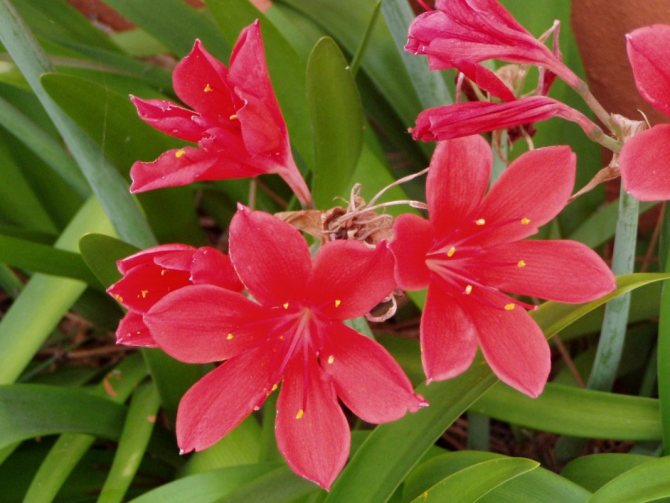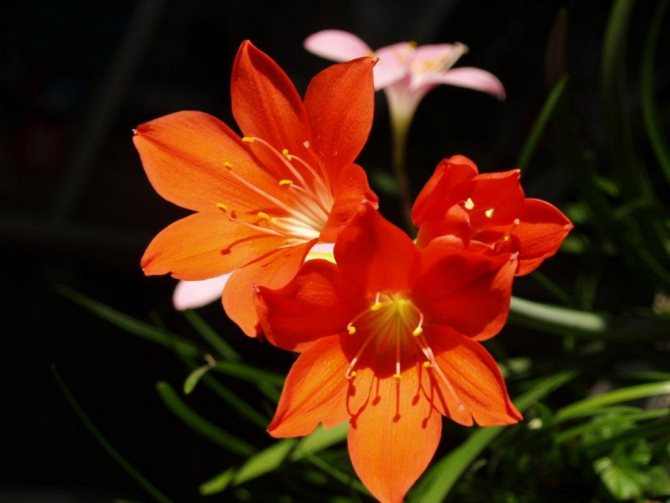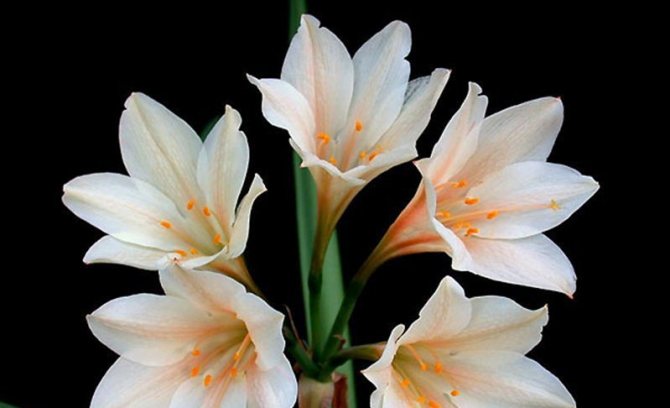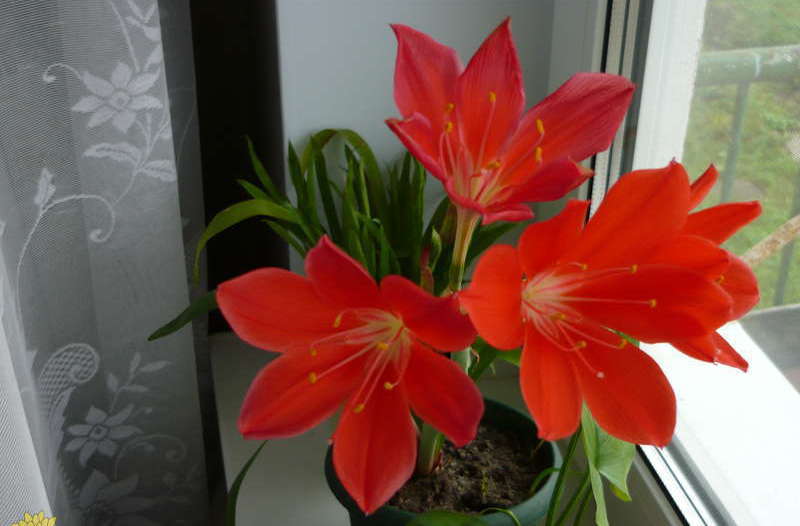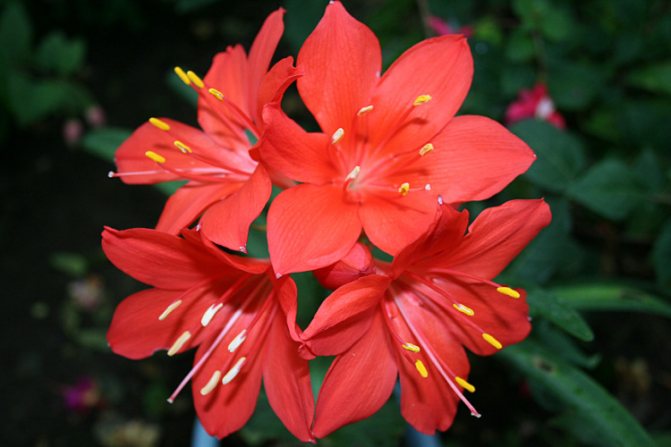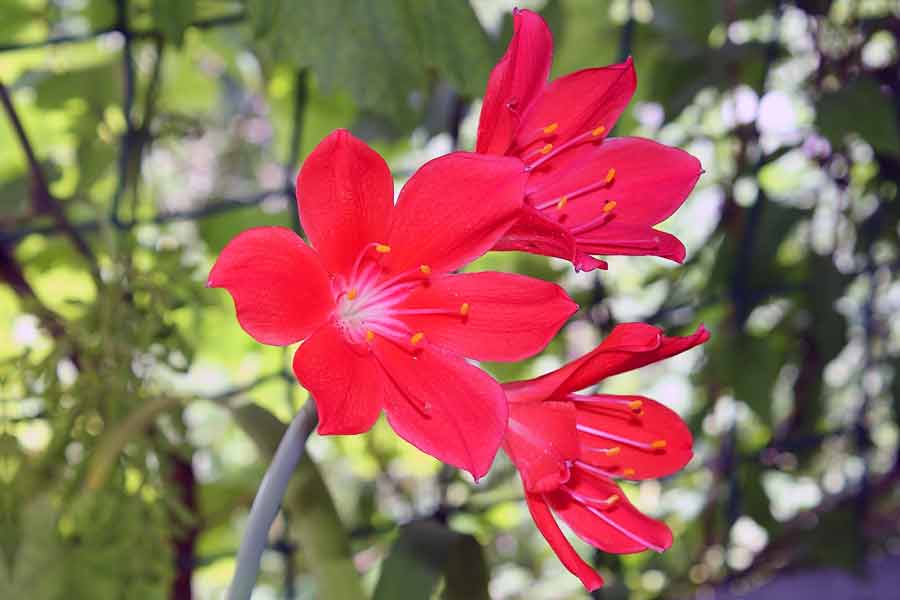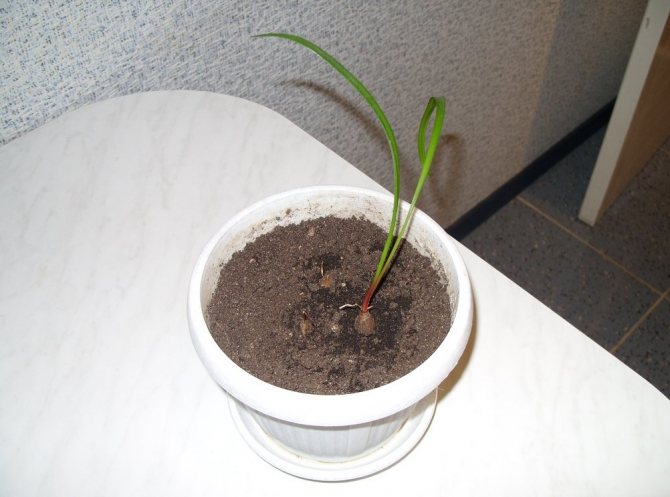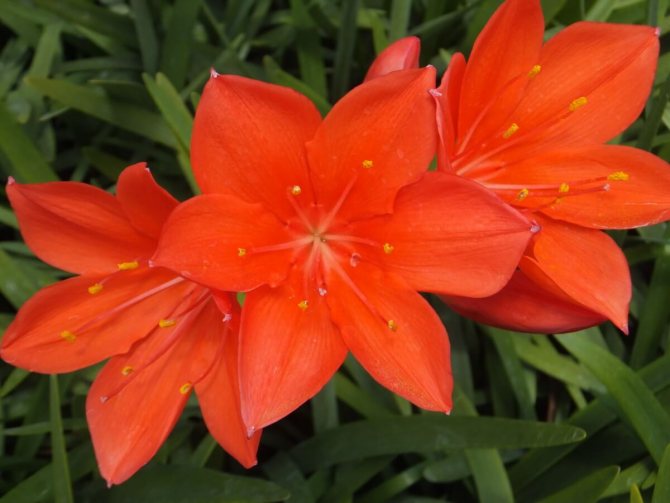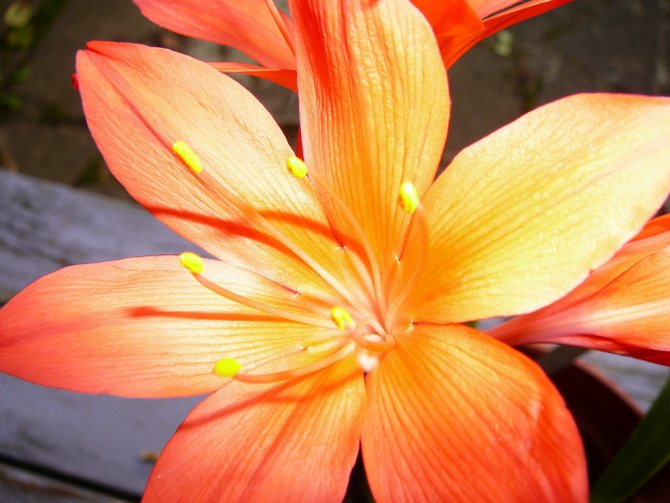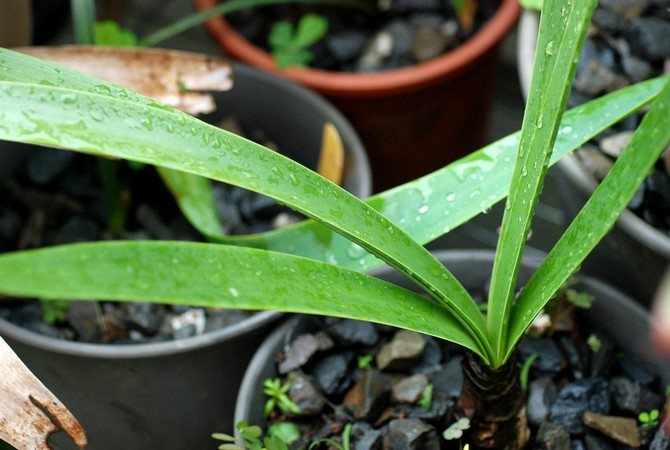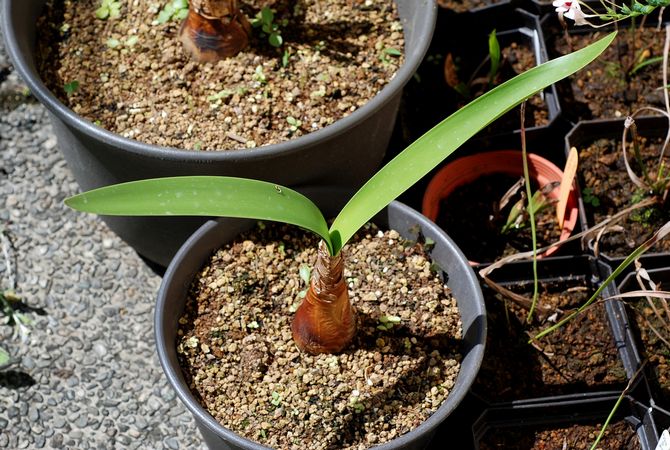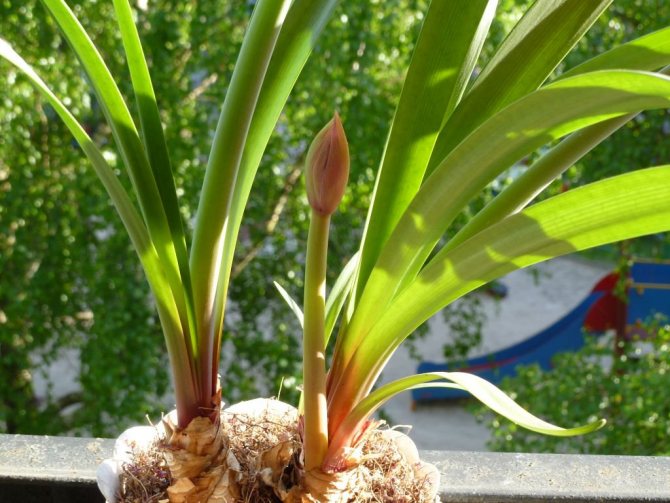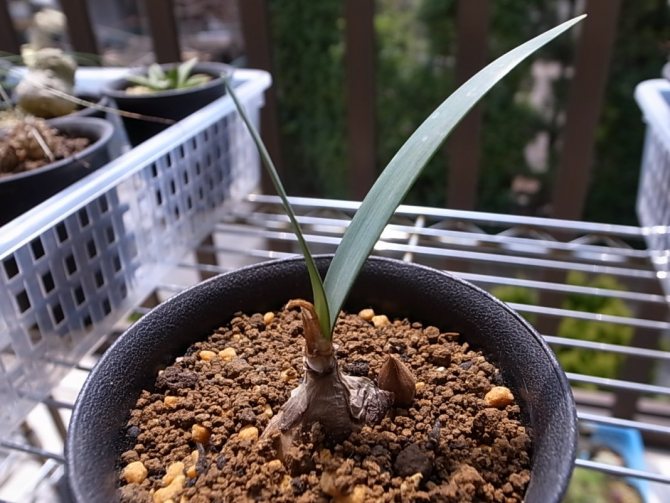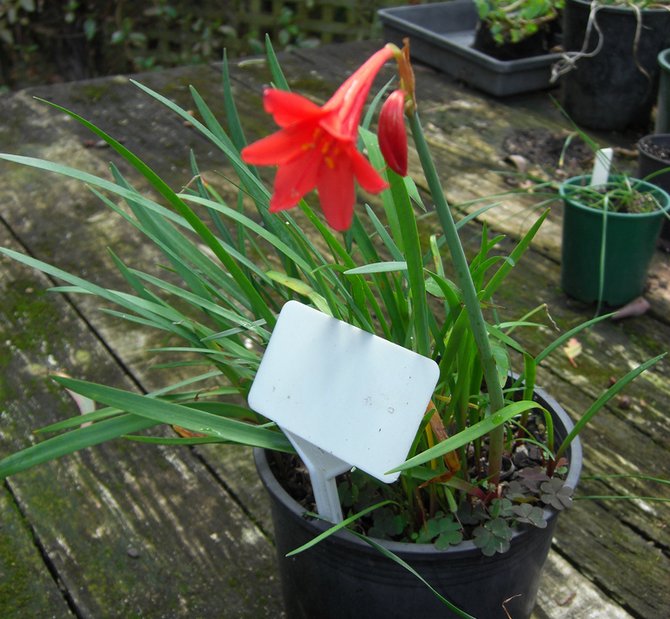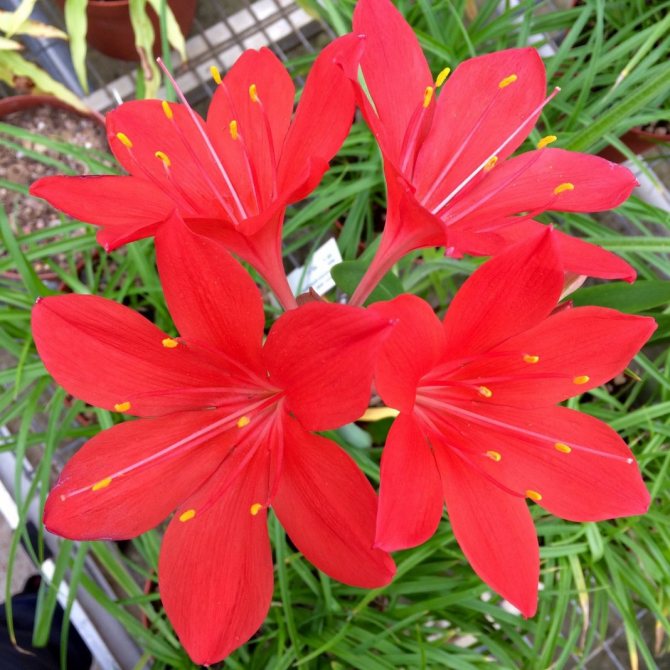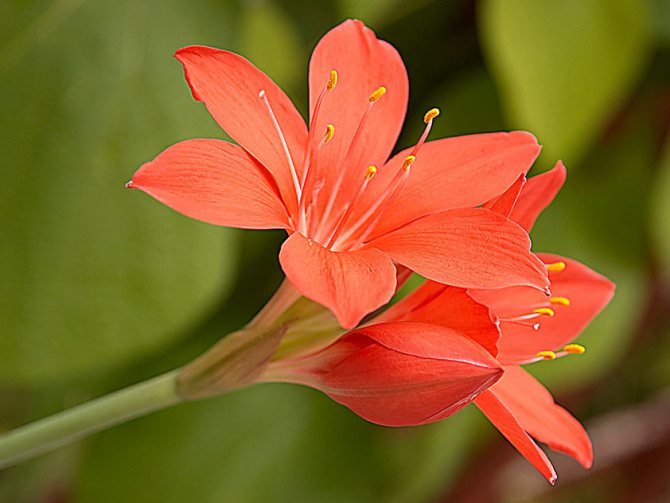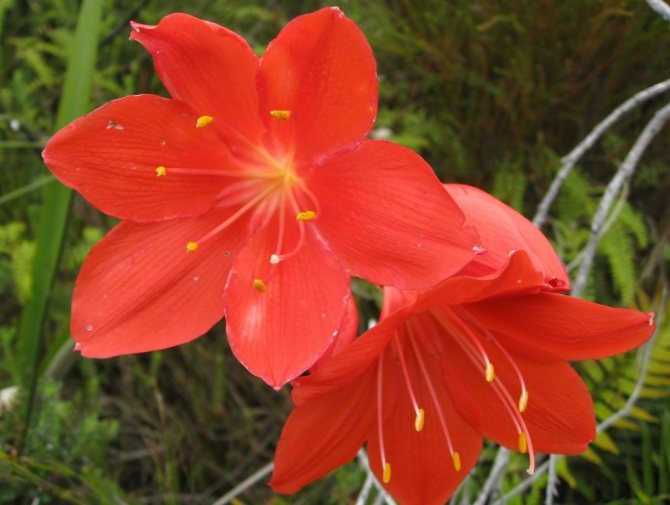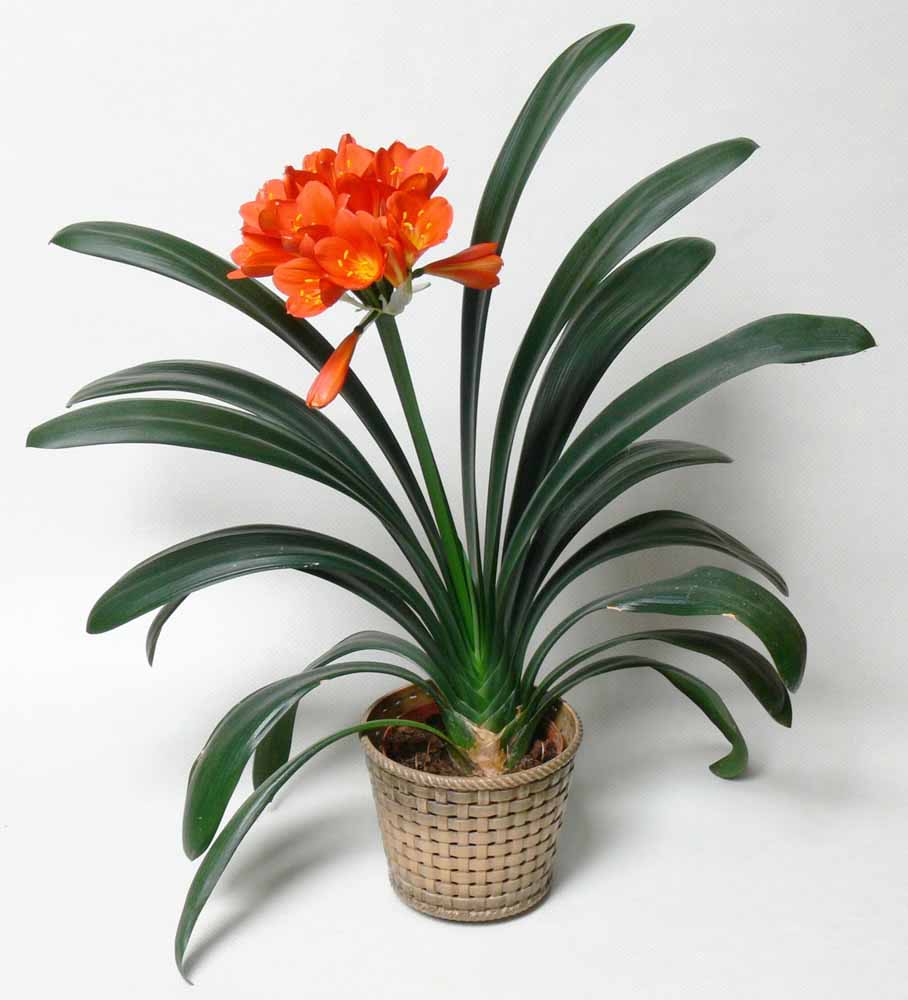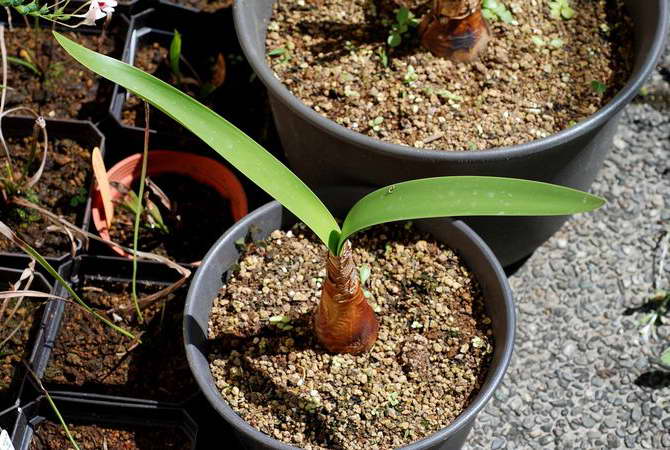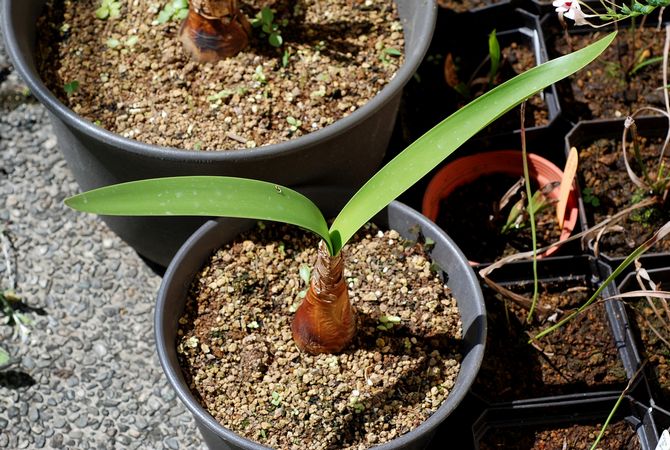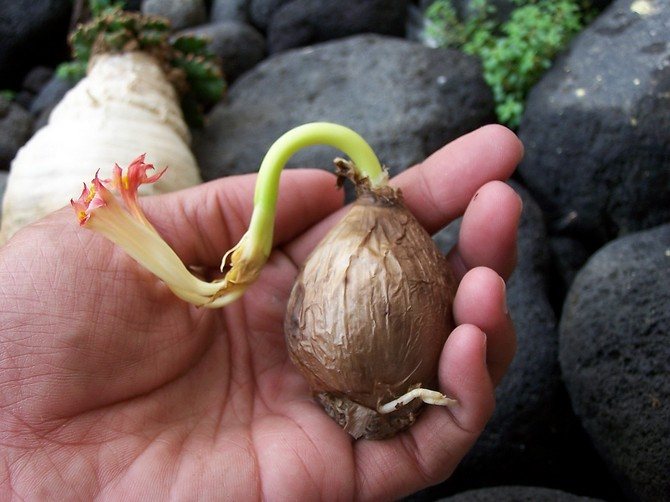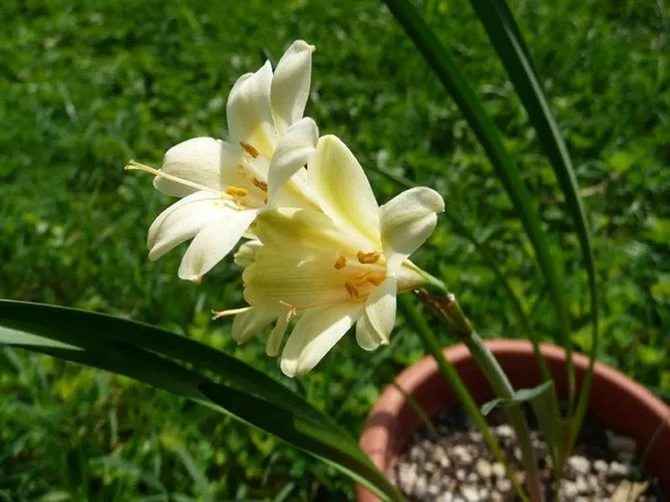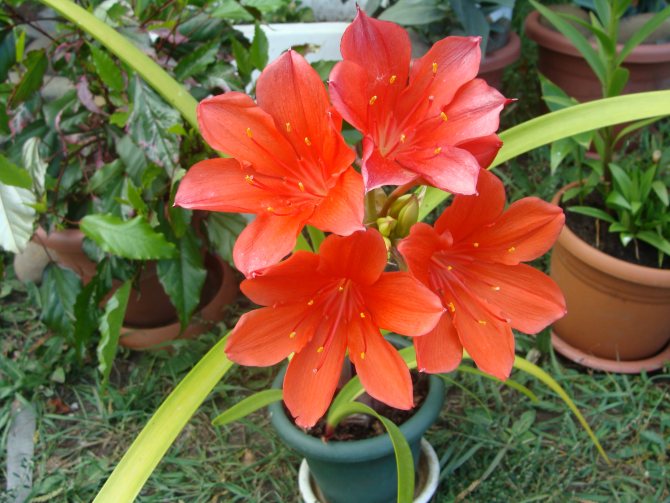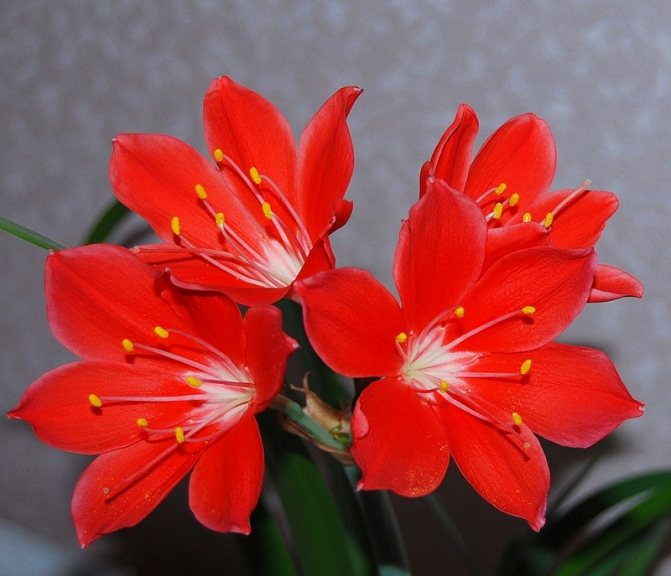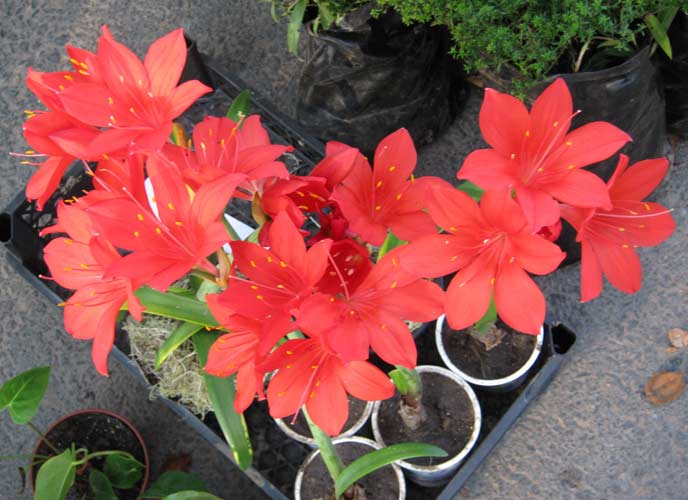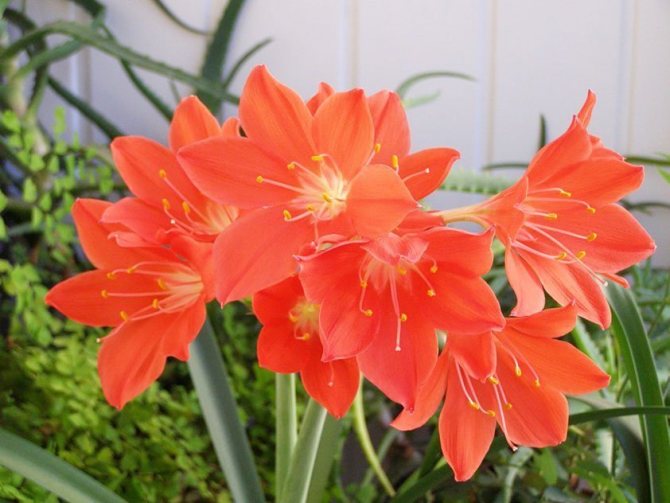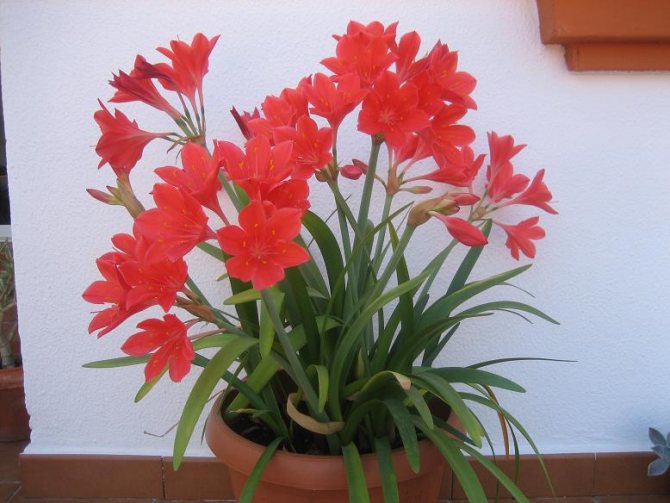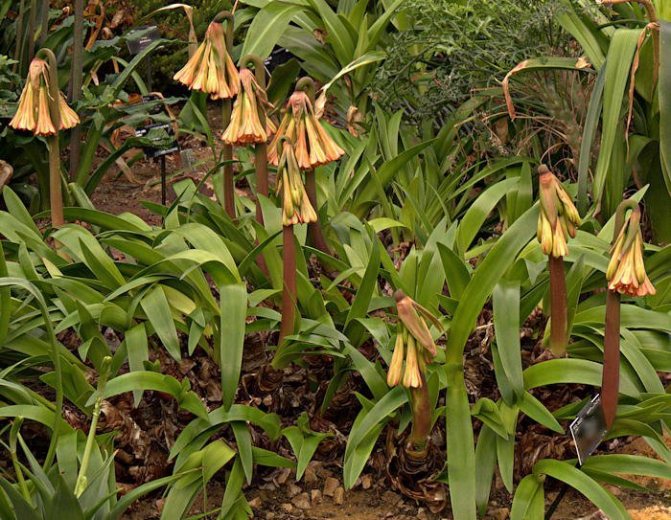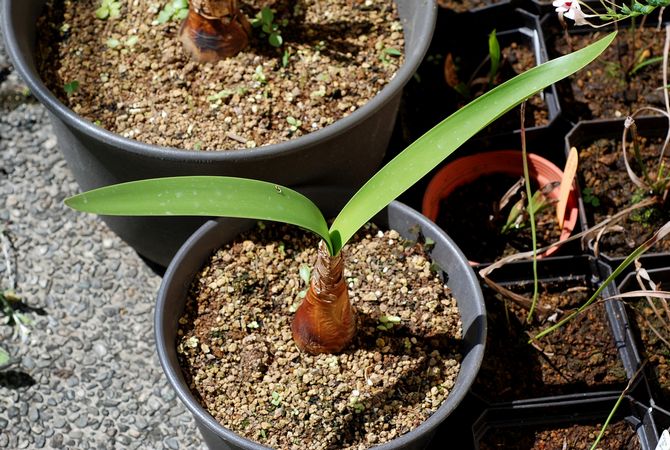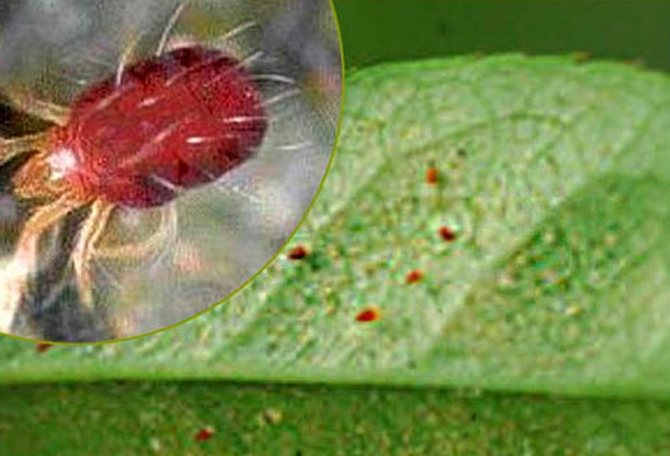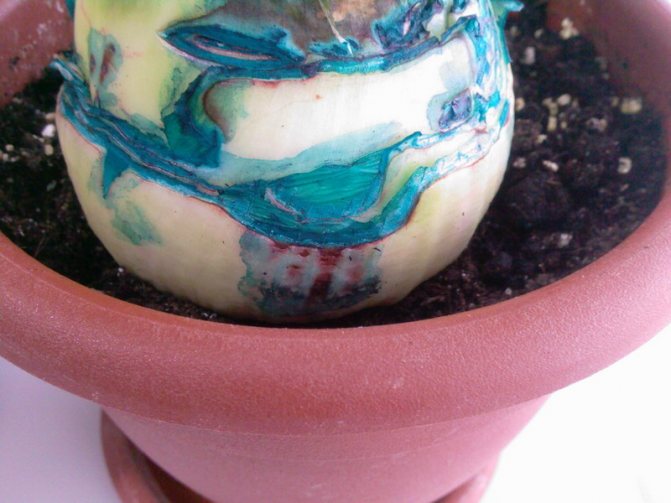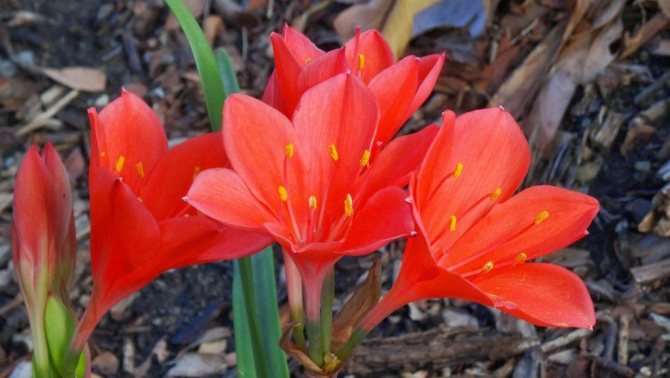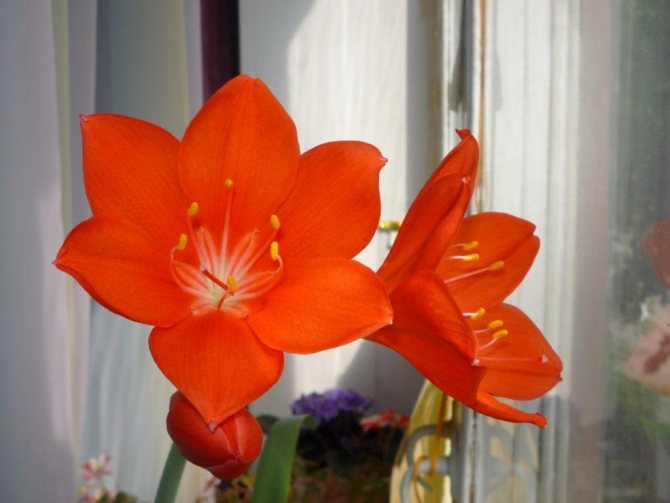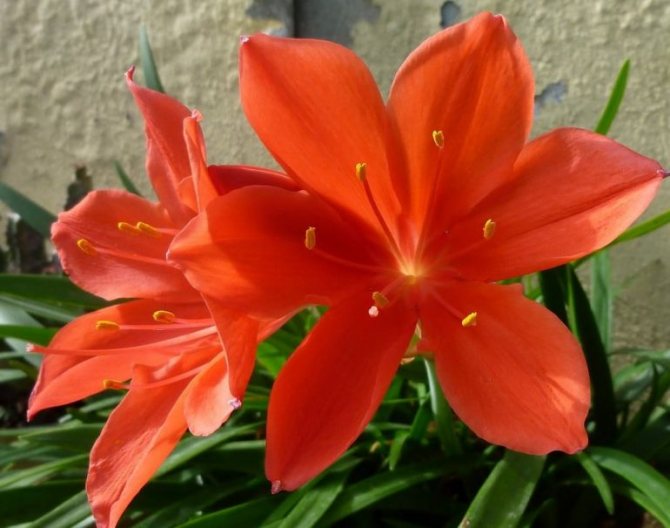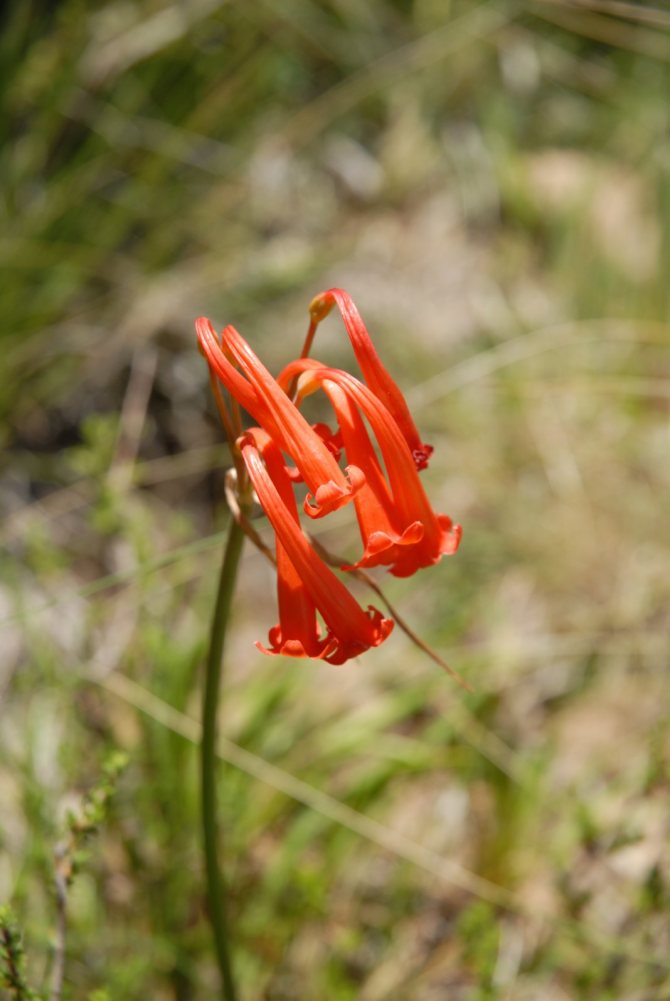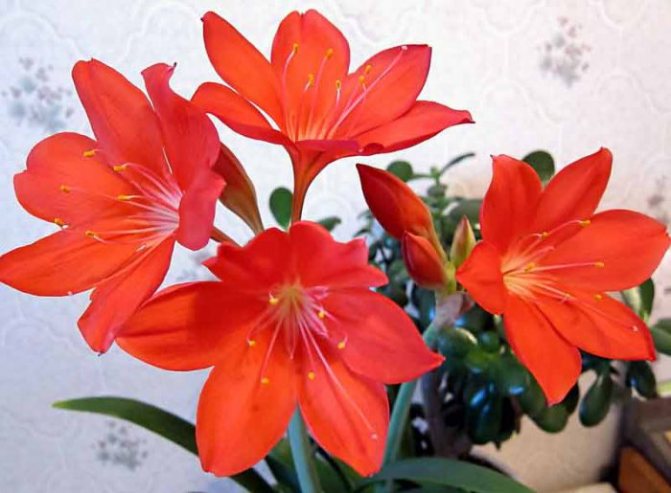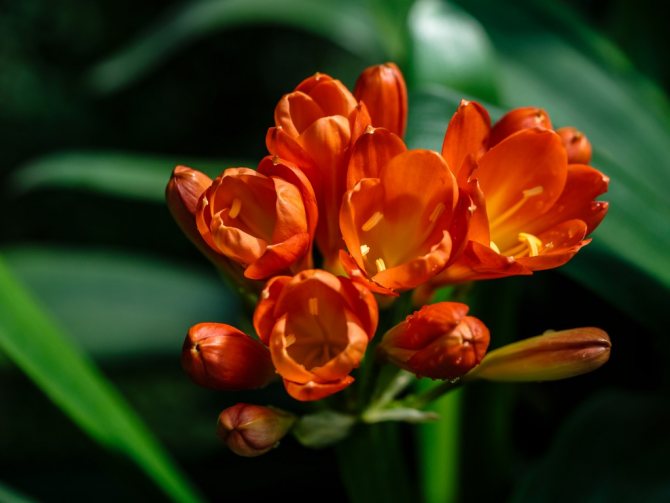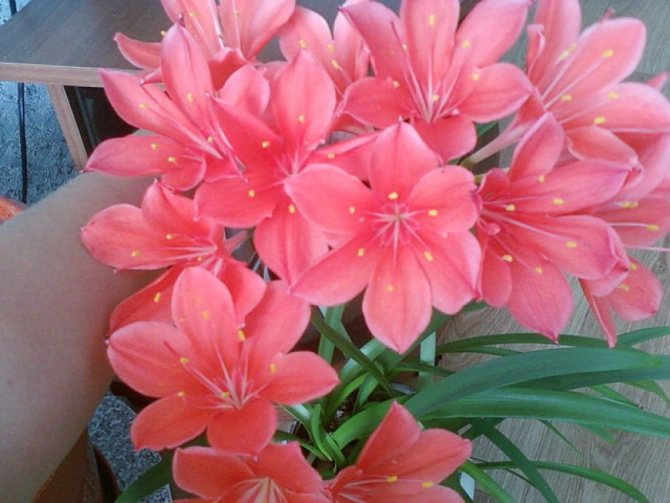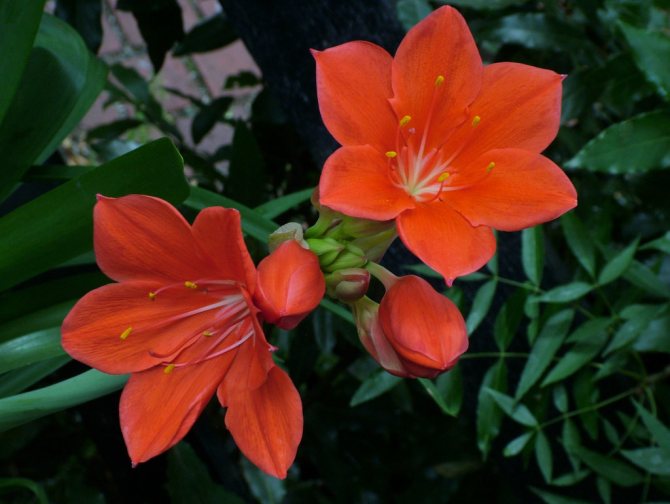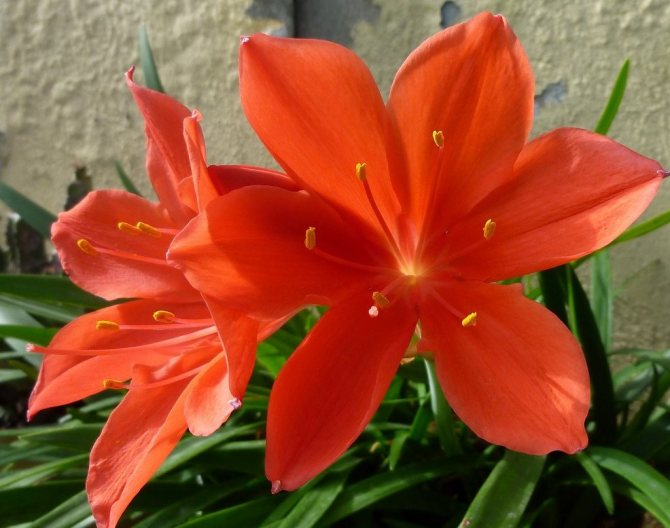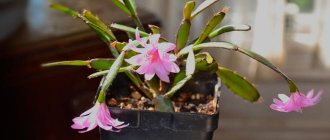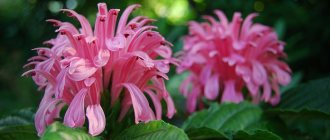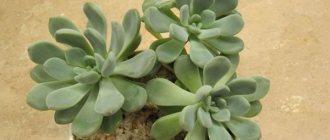Some indoor plants are valued because of their beautiful or unusual foliage, others because of their abundant and long flowering, and still others are attracted by flowers that appear once a year, but amaze with their splendor. Such beautifully flowering plants include the beautiful vallot, which has another name - sublime cirantus.
Useful properties of Vallotta
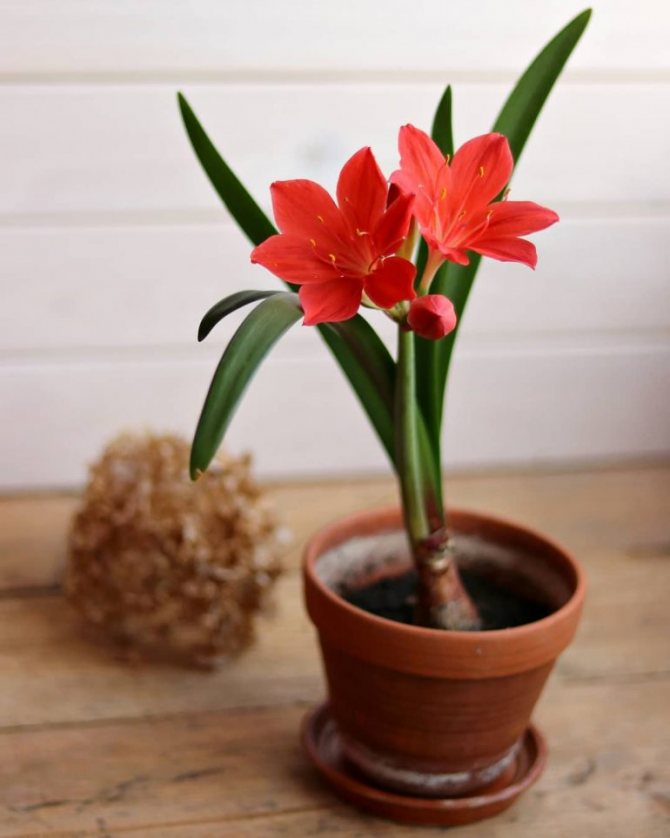
Despite the fact that the exotic beauty wallota is poisonous, it is beneficial. The positive properties of the plant lie in its beauty. The contemplation of a blooming vallot is an incomparable aesthetic pleasure.
The joy of communicating with a representative of the flora improves mood, increases the tone of the body. The plant emphasizes the individuality of the interior, creates a cozy atmosphere in the house.
Benefit and harm
Having got a beautiful decorative flower Vallota, you will get a lot of joyful emotions, a living interior decoration. Admire the beauty grown by your own hands, rejoice, raise your tone and mood. The decorative flower diversifies the design solution of the interior of the living space.
Every flora needs protection. Vallota the beautiful protected by nature.
Remember! Vallota speciosa poisonous... If children live at home, make sure not to touch the leaves, inflorescences. Limit access to pets. Bulbs are especially poisonous, they contain a high concentration of poison. Perform work strictly using gloves. Thoroughly wash your hands and tools with soap, completing the procedure.
Vallotta: home care. Briefly
In order for the vallot to develop harmoniously at home, you should find out the preferences of the plant and create a favorable environment for it:
| Temperature regime | Not higher than + 28 ° C - in summer; in winter they are kept at + 12 ° C. |
| Air humidity | Average, in the summer the plant is sprayed. |
| Lighting | In summer, in the heat - scattered, the rest of the time - bright sunny. |
| Watering | In the spring - in the summer - once every 7 days (more often in the heat); in winter - once every 12 days. |
| Soil for Vallotta | Loose nutritious; a mixture of garden soil, humus, sand and peat, taken in equal parts. |
| Top dressing and fertilization | In spring and summer - with diluted liquid mineral fertilizer - every 14 days; in the fall, the frequency of dressings is reduced, in winter they are stopped. |
| Vallotta transplant | In the spring, every 2.5 years; more often replace the topsoil. |
| Reproduction | Children and seeds. |
| Growing features | Vallota does not throw off the leaves for the winter, they remain green. Therefore, the plant must continue to be looked after: kept cool and sometimes watered. The more leaves you can save over the winter, the better the flower will feel. |
Growing problems
When growing a vallot, some problems are possible, even despite its unpretentiousness:
- As stated above, in the absence of flowering, the plant can be transplanted into a smaller pot. You also need to adjust the temperature and lighting conditions.
- At low humidity, the tips of the leaves may turn yellow. Spraying will bring everything back to normal.
- Waterlogging of the soil leads to rotting of the base of the bulb.
- Fertilizing can correct the problem of sagging and blanching leaves.
- Yellowing and falling leaves may indicate a recent transplant or non-compliance with watering measures.
Caring for a wallot at home. In detail
Vallota is a beautiful overseas plant. In indoor conditions, it takes root well and blooms luxuriantly, if you create a favorable atmosphere.
Dormant period
Having finished flowering, the vallotta will hint that she needs a period of rest by wilting of the peduncle. This often happens in mid-September. Completely wilted peduncle is removed. Vallota is moved to a cool place and kept at a temperature of about + 12 ° C.
Watering should be sparse to support the leaves and prevent root rot. Top dressing stops.
Preparing for flowering
In early April, the vallotta will begin to wake up and release leaves. It is at this time that the phased preparation for flowering begins. It is impossible to admit extremes and rush, the quality of future flowering depends on this. Gradually increase the temperature of the content, without bringing it to a sharp increase.
The plant is fed with complex liquid fertilizer, diluting it in half. When the peduncle appears, the dose of phosphorus in the dressing is increased: the element stimulates flowering. The substrate should always be moderately moist. Make sure that there is no stagnation of moisture.
Bloom
Plants from the Amaryllidaceae family bloom not only beautifully, but bewitching. The flowering of the vallotta is an unforgettable sight, despite the fact that the color range of species is mainly limited to red-orange shades. One bulb forms two or more strong peduncles, the height of which does not exceed 0.4 m. On each of them, up to 7 large flowers - gramophones - bloom.
Their diameter often exceeds 5 cm. Flowers are collected in inflorescences - umbrellas. Golden stamens emphasize the delicate texture of the petals. The lifespan of the peduncle is up to a week. During flowering, the wallot continues to be fed. Water it carefully, trying not to wet the flowers. They protect the plant from drafts and sudden changes in temperature.
Temperature regime
For plants with southern roots, it is imperative to maintain a temperature regime, otherwise they will develop unevenly, slow down growth, and will not bloom. In winter, the vallotta plant at home should be kept at a temperature not higher than + 28 ° C, and in summer - at + 12 ° C.
The flower does not tolerate drafts and sudden changes in temperature. In summer, the Vallotta enjoys breathing fresh air in the garden or on the balcony.
Spraying
The flower feels comfortable when the room has average humidity. Caring for a vallot at home recommends spraying it every day in the summer. This must be done very carefully, without getting on the flowers. To maintain the humidity at the proper level, an open container of water is placed next to the plant, sometimes a humidifier is turned on. Periodically wipe the leaves with a soft damp cloth.
Lighting
A southern plant is pleased when light falls on it. The sun's rays have a beneficial effect on its development, activate vitality. The home wallot loves bright sunlight, but on hot days it must be shaded, otherwise burns cannot be avoided. The windows facing south, southeast and southwest are the most suitable for placing a wallot.
North facing windows excluded: the flower will stretch out, suspend the growing season. But in winter, experienced flower growers recommend placing a pot with a vallot on the northern windows so that the plant can relax and fully rest. In the spring, the flower is returned to its former - well-lit - place.
Watering the Vallotta
It is necessary to monitor the soil surface and prevent the formation of a crust on it. Watering the vallot during the period of flowering and intensive development is carried out when the soil begins to dry out.
This usually happens once every 7 days, during the heat - a little more often, in order to prevent the leaves from drying out (the vallot is very painfully going through all the changes associated with them).After flowering, the frequency of watering is reduced; in winter, watering is required on average every 12 days. For irrigation, use lukewarm, well-settled water.
Vallotta pot
The result of the harmonious development of the vallotta is its lush, long flowering. It is important for a flower grower to create optimal conditions for the plant to show its wonderful "bells" to the world. In this case, the pot for the vallot is of great importance. If you buy a container that is too spacious, many children will form, and the vallot, instead of blooming profusely, will take care of them, giving strength to the development of bulbs.
Therefore, the pot needs a little cramped. The diameter of the bulb of an adult flower is approximately 80 mm. The distance from it to each wall of the pot should be no more than 40 mm, which means that the diameter of the container for an adult wallot is 160 mm. A young plant needs a pot with a diameter not exceeding 100 mm. The height of the container should not exceed its diameter.
When buying a pot, you should always look to see that there are drainage holes at the bottom.
Priming
Nutrients from the soil should freely flow to the roots of the plant, then the vallot will develop well. This is possible if loose and permeable soil is taken for planting a flower. In the store, you can buy a universal substrate for flowering plants and supplement it with charcoal powder, chopped spruce bark, sphagnum.
To improve drainage properties, brick chips and vermiculite are added to the ground. You can independently prepare a soil mixture by taking humus, garden soil, peat, sand in equal proportions. They improve the composition with the same components as the finished substrate.
Top dressing and fertilization
In order for the vallot at home to develop harmoniously and bloom beautifully, fertilizing and fertilization are necessary. Use a universal complex fertilizer for flowering plants. The product is used diluted after evening watering. Liquid fertilizer is better absorbed by the roots, while reducing the risk of overfeeding the plant.
An overfed flower will grow green and bloom poorly. This will reduce the decorative properties of the vallotta. Top dressing is carried out during the intensive growing season once every 14 days. After flowering, the frequency of the procedure is reduced, and in winter they are stopped altogether. After feeding the plant, it is shaded for a day.
Transfer
Vallota is a bulbous plant. She is very sensitive to any external influences. Usually, a vallotta is transplanted every 2.5 years, in the spring. The plant is very carefully taken out of the pot, being careful not to damage the bulb and roots. A flower transplant is a reason to change the pot, soil and increase the drainage layer.
When transplanting a vallot, the bulb is not buried so that the base of the stem does not rot. Above the surface of the substrate, its third part should rise. After the procedure, the vallot will take a long time to get used to the new place and will not immediately continue to develop. Having grown roots, the flower will develop its upper part.
After transplanting, the wallot should be placed in a place protected from direct sunlight. Instead of transplanting an adult plant, the top layer of the substrate is often replaced. After three weeks, the wallot can be fed.
How to trim a wallot?
Vallota needs pruning to get rid of completely dried leaves. If the leaf has not completely changed color, it is not touched until the entire surface is dry. After flowering, completely wilted peduncles are also removed.
Description of the plant
The beautiful vallot (Cyrtanthus elutus syn. Vallota speciosa) belongs to the amaryllis family. This is a bulbous plant that came to us from the Cape province in South Africa. As a houseplant, vallotu has been actively cultivated since the 17th century. This flower is a long-liver, one bulb, under favorable conditions, lives up to 20 years. The older the plant, the more abundantly it blooms.
The bulb is ovoid; with age, the middle of it expands slightly, and it takes on the shape of a pear.Diameter - from 4 to 8 cm. The neck of the bulb is wide, smoothly into the leaves. Vallota forms many baby bulbs, which are located not at the bottom, but closer to the top.
The leaves spread out on two sides in the form of a fan. The leaf is belt-shaped, the length is from 30 to 50 cm, and the width is about 3 cm. The middle vein of the leaf is poorly visible, because of this it seems flat. The color is dark green, and the base closer to the bulb is purple or red. A feature of the plant is that with age, the leaves that are below gradually turn yellow, then they wither and dry out. For lower foliage, this is a natural process. You should not remove those leaves that begin to die off. They fall off on their own, leaving a dry scale in place, tightly pressed against the remaining leaves. Thus, a short stem is gradually formed.
The peduncle appears from the center of the bulb, it is hollow. It grows rapidly, up to two centimeters per day. Its final height is about 35 cm. Flowering begins 3 weeks after the appearance of the peduncle.
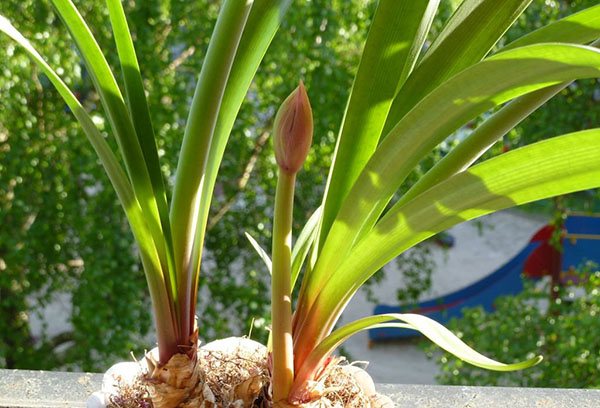

Breeding Vallotta
Reproduction of the vallot is possible in two ways.
Growing a wallot from seeds
Held in October or November. The seeds are soaked in a saturated solution of potassium permanganate and germinated between layers of moistened gauze or filter paper. Sow into the substrate to a depth of about 50 mm. Cover with glass or foil, germinate with lower heating. The shelter is removed to water and feed the seedlings. Shoots appear after 20 days. After 3.5 months, small bulbs are transplanted, completely immersed in the ground. The plant is watered moderately. A year later, in spring, the grown bulbs are transplanted so that the root collar is slightly visible above the soil surface. Vallota planted with seeds will bloom in 3 years.
Reproduction of the vallot by children
Carried out after transplantation. The formed bulbs are carefully separated from the roots of the mother plant and planted in small pots, buried 2/3 into the substrate. At first, seedlings are rarely watered. Vallota, grown from children, blooms for the second year.
Growing a beautiful large plant from small seeds is a long process. Therefore, the second method of reproduction is most often used. It is also popular because the flowers planted by children are more like a plant - "mother".
The red flawlessness of a simple but not humble cirtantus
The belonging of all zirtanthus to flowering crops is undeniable and obvious. And although most of the year these plants look rather plain, and sometimes spoil groups and collections of other plants with their leaves, with the beginning of flowering they are transformed as if by magic. These are special indoor bulbous, which are easy to recognize at first glance by the flowering palette, and by the shape and size of the flowers. And even if there is a lot of confusion with the name of Cirtantus, which was mainly caused by the constant "migration" of certain species in the Amaryllis family and a change in status, either as an independent genus, or as part of a larger group of plants, whatever you call them, are beautiful and recognizable.
The most popular as indoor plants have won crops, which are still known to most flower growers under the old name Vallota. The most attractive species of these plants were reclassified into the genus citantus (Cyrtanthus), combining them into one species with the most prominent representative of the authentic Cyrtanthus, but this does not prevent the outdated name from remaining the most popular. But whatever you name it, all plants practically do not differ from each other in decorative details. In our country, they are often called simply red indoor lilies, although they have nothing to do with lilies.And in their homeland, Cyntanthus are known as the "lily of forest fires" because of their ability to bloom violently after spontaneous forest fires.
Cyrtantus are representatives of a not so large, but incomparable and irreplaceable group of indoor bulbous of the Amaryllis family. This is a plant with a pronounced dormant period, but does not shed its leaves, but only stops developing. It is quite easy to distinguish the cytantus bulb from hippeastrum and other bulbous plants: ovoid, oval-elongated, with brown scales, it surprises with reddish spots on the root collar, which seem to hint at an unexpected decoration of leaves and color of flowers. This plant forms daughter bulbs annually, but they negatively affect the ability of the main bulb to bloom: unlike many of its relatives, Cirtantus blooms better alone, and not when grown by a "family". The leaves are typical for all large-flowered bulbous plants. Belt-shaped and rather narrow, they flaunt with their glossy surface and dark green color, which somewhat revives the reddish tint at the very base of the leaves. Unlike hippeastrum, which is often compared to cirtantus, in the latter the leaves are arranged not in a fan, but in a bunch. This culture reacts very painfully to the loss of leaves, and even during its dormant period, one should try to preserve as much greenery as possible.
The flowering of vallot-tirantus traditionally occurs in the summer, but strong bulbs can bloom twice a year - in spring and autumn. The flowering of the vallotta is easy to recognize. One bulb produces 2 or more powerful peduncles up to 30 cm high. They are crowned with large, bell-shaped, up to 5-6 cm in diameter, symmetrical, with narrow corolla petals, bright red, scarlet-purple or orange-pink gramophone flowers. On each peduncle, 2-3 and up to 8 flowers can bloom. Among the ciranthus, there are also plants with a different flowering, lasting from autumn to spring.
The color palette of all zirtanthus is quite limited. It includes only red-pink colors; very rare white-flowered ciranthus.
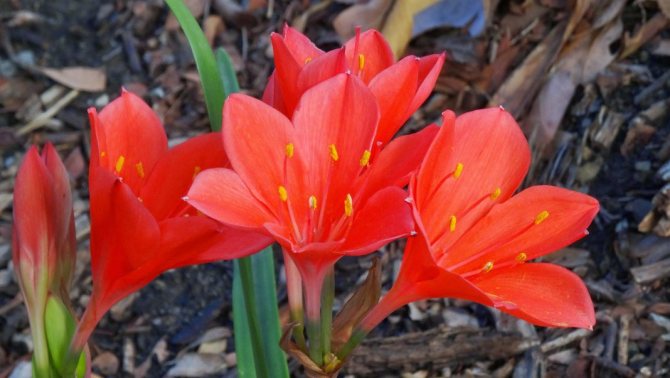

Cyrtantus tall, or sublime cyrtanthus (Cyrtanthus elatus), or beautiful Vallota (Vallota speciosa).
Diseases and pests
Diseases and pests rarely affect the plant. Due to improper care, problems often appear:
- the tips of the leaves dry vallots - the plant is hot (ventilate the room, protecting the flower from a draft; spray);
- brown spots on the leaves - a sign of gray rot due to the content at high humidity and in shading (cut off the affected leaves, treat the plant with a fungicide; ventilate more often);
- leaves wither, shrivel - a sign of fusarium (remove all damaged parts, sprinkle the cut points with sulfur or coal powder; if the plant is badly damaged, it cannot be saved);
- vallotta does not bloom - lack of a dormant period; keeping in a poorly lit place and growing in a spacious pot (keep cool in winter and rarely water; rearrange to a brighter place; transplant into a tighter pot).
Most often, the vallot is affected by aphids, mealybugs, scale insects, spider mites.
Growing conditions
For the regular flowering of the beautiful vallotta, a lot of light is required. It is recommended to place it on the east, south-west and south windows. On the south windows, shading will be required at noon in summer to prevent sunburn. North windows are not suitable for this flower due to too poor lighting.
In the warm season, flower pots can be taken out to the loggia or veranda. Vallota feels good if you take her out into the garden, but at the same time you need to choose a place that is protected from rains and the scorching sun. There should be no sudden changes in temperature during the day and night.
Vallota tolerates room climate well in summer, when the air temperature in the room is + 20-25 ° С.In winter, this flower needs a dormant period so that the bulbs can rest and build up strength for a new bloom. The temperature during this period should be lowered to + 10-15 ° C.
Dry room air is not terrible for the vallot; spraying is required only in very hot weather.
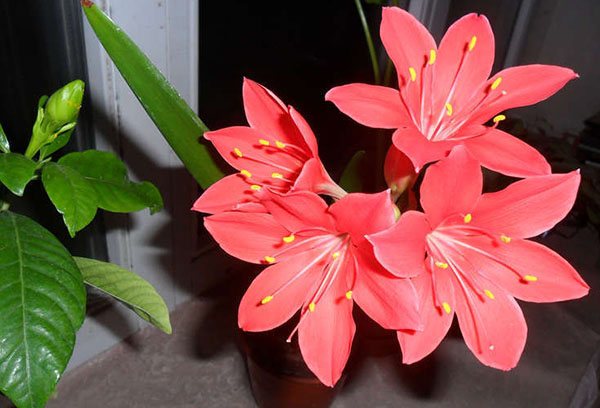

Types of home wallots with photos and names
In domestic culture, two types are widespread:
Vallota speciosa
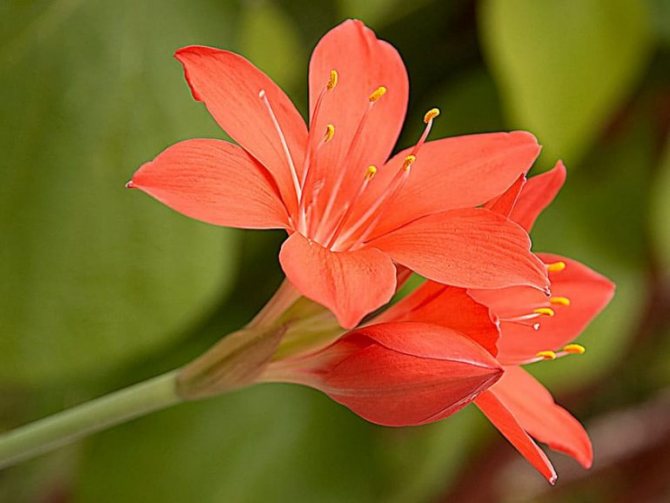

The height of the plant is about 0.65 m. The diameter of the flowering bulb is up to 45 mm. The flowers are very similar to lilies. The bright red petals with an orange tint are oval in shape, slightly pointed at the end. Umbrella inflorescences are wide open and directed upwards. The leaf plates are long (about 40 mm) and wide (up to 30 mm), have a belt-like shape, and are colored dark olive. The species blooms in mid-August.
Popular types of Valotta
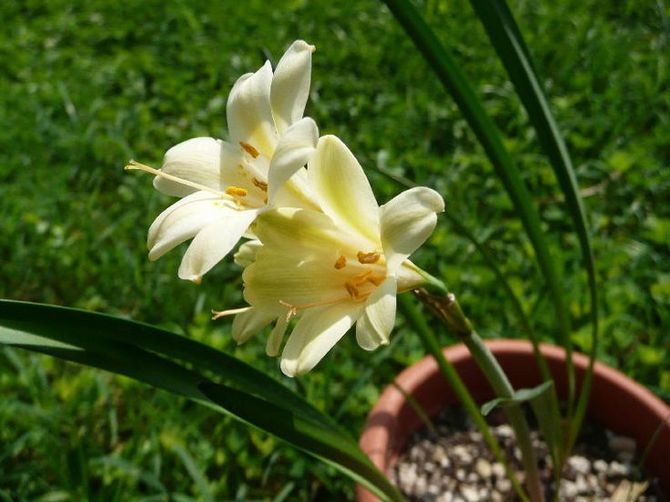

The plant has only three varieties, for which there are still disputes about where to attribute them. For example, the beautiful and purple vallotta was singled out as a separate subspecies of citranthus, and the dwarf vallota - in the Clivia subspecies.
Vallota the beautiful
The plant is also called Citrantus, purple Amaryllis, beautiful Krinum. Its brown scaly bulb has an oblong shape. A leathery leaf with a length of 40 cm has the appearance of a sword and a dark green color. The stem with inflorescence emerges directly from the center of the bulb and reaches a height of 30 cm. It has no sepals, but inside it is empty. The umbrella unites 3-6 flowers at once. 6 petals form one bud. The petal has parameters: length 8, width up to 10 cm. There are mainly burgundy and bright orange flowers, the only exception is the genus Alba with white petals.
How does a flower propagate?
Rooting babies
The easiest way to get a new plant or several is to root its daughter bulbs. This breeding method is provided by nature itself. If the plant is planted correctly, then the bulbs can be separated from the mother plant without digging it out of the pot. When properly planted, vallottes take root almost by themselves and bloom in 1.5–2 years.
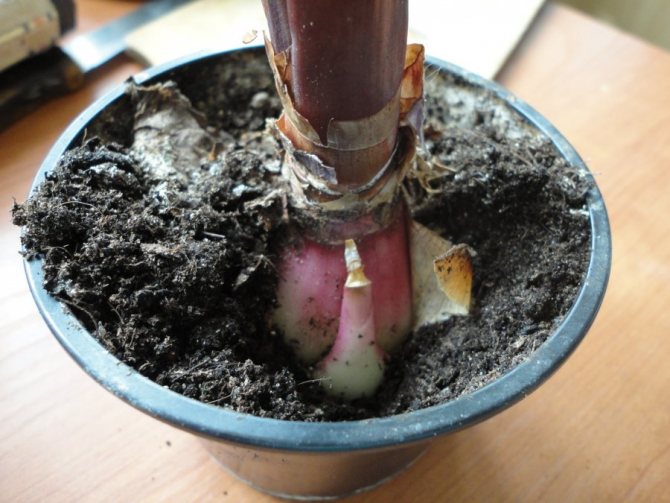

Vallota babies are visible immediately because of how they grow
- In the process of transplanting, separate the “offspring” with a diameter of 1 cm or more from the mother bulb. It is desirable that they do not have a "leg" connecting them to the "parent". Otherwise, the percentage of rooted plants is greatly reduced. The same applies to bulbs without roots.
- Prepare small containers with a mixture of peat chips and sand (1: 1). Some growers recommend rooting the bulbs in moist sphagnum moss.
- To prevent rot, soak the "kids" in a solution of any fungicide for 15–20 minutes. If roots are missing, sprinkle the bottom of the bulb with any powdered root stimulant.
- Provide plantings with a temperature of 20-22 ° C. Moisten the substrate moderately as it dries.
- The bulbs take root after 12-15 days. After the appearance of the first true leaf, the vallots are transplanted into the soil for adult plants.
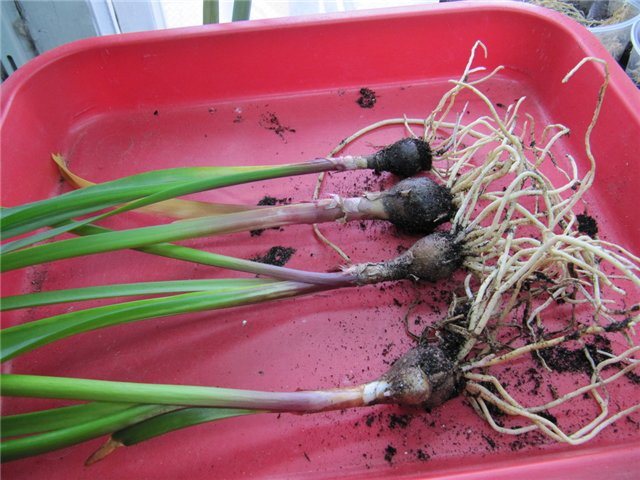

The better developed the daughter bulb itself and its root system, the higher the likelihood that rooting will be successful.
Dividing the bulbs
Large healthy vallotta bulbs aged from 5 years in the absence of "offspring" can be cut into 2 or 4 parts. The procedure for their rooting is no different from planting "daughters". In order for rooting to be successful, the bulbs need to be cut only with a sharply sharpened sterile knife and sprinkled with activated carbon powder, sifted with wood ash, and colloidal sulfur. And be sure to save a part of the bottom on each piece.
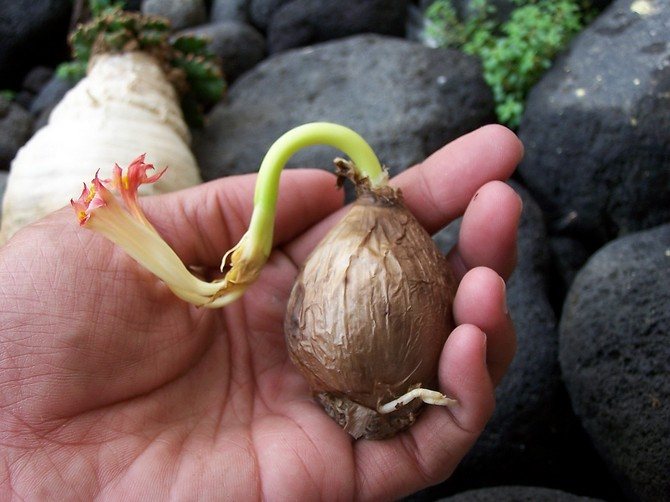

If the vallotta bulb does not have children, it can be divided into parts.
Seed reproduction
Since the vallota, with proper care, blooms annually, and sometimes even twice a year, there will be no seed deficit. They are formed even with artificial pollination.... However, it should be remembered that the flowering of plants grown from seeds will have to wait at least 3-4 years. In addition, plants do not always retain the varietal characteristics of the “parent”. This is especially true for breeding hybrids. Another disadvantage of this method is that the harvested vallotta seeds quickly lose their germination. Sowing them later than six months after harvesting is pointless.
- After flowering, do not cut the peduncle. Collect the ripe seeds after 4–5 months. The "boxes" in which they are located must crack at the seams. The seeds themselves are round, flat, glossy black.
- Fill flat, shallow containers with a mixture of peat chips, fertile turf, all-purpose potting soil and sand (2: 1: 1: 1). Moisten the substrate well.
- Spread the seeds out on the surface of the soil, pressing them slightly inward. Leave about 4 cm between the seeds, 5–6 cm between the rows. Moisten the planting again. Create a greenhouse by covering the containers with plastic bags, glass jars, cut plastic bottles.
- Provide seeds with bright diffused light, temperature about 16-18 ° C, bottom heating. Under optimal conditions, seedlings appear in 20-25 days.
- After 5-6 months, transplant the seedlings into small individual containers with the same soil. The neck of the bulb must necessarily protrude from the ground.
- After a year and a half after planting the seeds, transplant the vallots into the soil for adult plants again. Groom as usual.
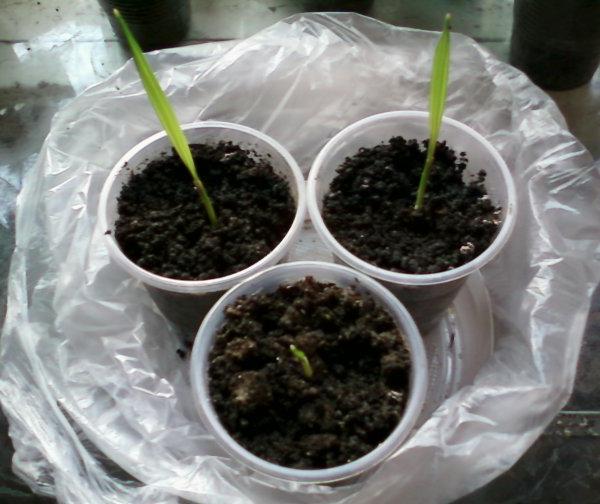

Vallota seeds germinate in about a month
White vallotta cultivar Cyrtanthus elatus Cream Beauty
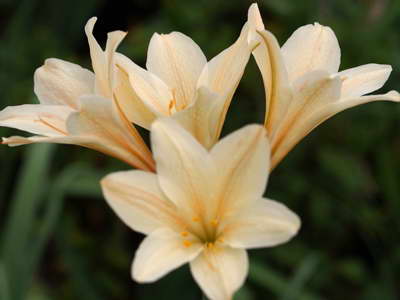

White vallotta cultivar Cyrtanthus elatus Cream Beauty photo
The combination of bright green leaves and delicate, beige-tinted flowers looks simply enchanting. Due to the fact that flowering occurs in the autumn period, the people called this species the autumn lily. On a peduncle, 0.4 m in height, 6 inflorescences sit tightly.
Growing a wallot from seeds
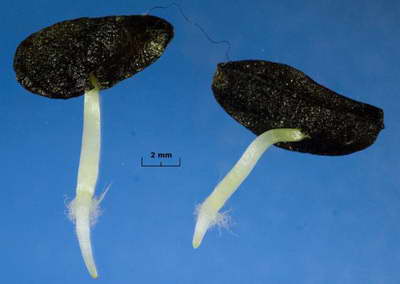

Vallota seeds sprouts photo
Seeds are harvested in September, after full ripening, and immediately try to sow so as not to lose germination. The composition of the soil must necessarily contain the following components: peat, rotted earth, sand.
- Before planting, seeds can be soaked for a day in a growth stimulator.
- Considering that the seeds of the vallotta are large enough, they can be planted one at a time in separate cups. The plant really does not like transplanting, and you will thank yourself for not having to transplant them later. However, many are not afraid of picking, so decide for yourself what is more convenient.
- After sowing the seeds, the container is covered with plastic wrap. They monitor the air temperature (optimal + 18 ° C), do not forget to ventilate, remove condensate.
- The first shoots appear in a month.
- They start diving only six months later, seating each sprout in a separate container.
- Lightweight, non-stagnant watering will provide the seedlings with the necessary amount of moisture. In winter, they need good lighting most of all. The indoor temperature, maintained at 16 ° C, is the perfect complement to light conditions. Watering is extremely rare.
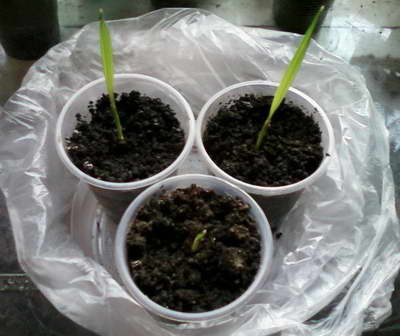

Vallota from seeds photo of young plants
After 2 years, the matured, grown seedlings are moved into slightly cramped pots. This is done in order to ensure early flowering. When planting, the neck of the bulb should rise two-thirds of its height above the ground.
The first peduncle is expected in 4 years.
Dormant period
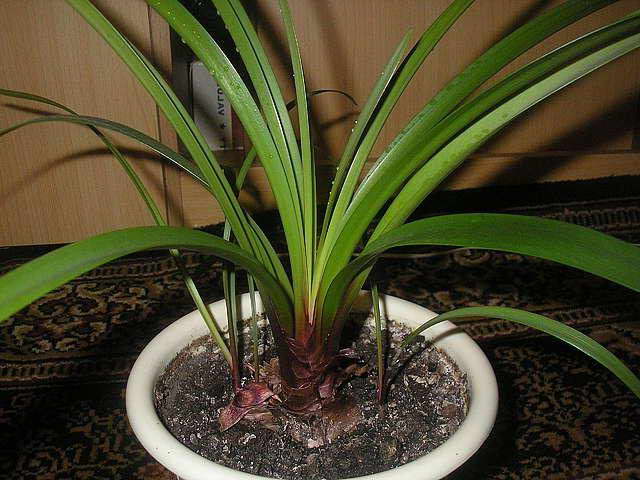

Vallota after flowering how to care for a photo
The signal to the fact that the vallotta wants to rest is the end of flowering. This period usually starts in September. Faded buds are cut off, watering is reduced and feeding is abandoned. The temperature of the content during the dormant period is preferable in the region of 12-16 ° C.
Watering should be done little by little, only slightly moistening the soil, only after the top layer has dried. It should be remembered that the bulb can rot from excess moisture, so it is better less often than more often.
Throughout the winter, the plant is kept dormant, watering only occasionally. Remember, the vallotta does not shed leaves during the dormant period, therefore, she still needs minimal care.
The use of zitantus in interior design
Most often, the wallot is planted in separate pots. One container can contain several bulbs or one or two. Ensembles with succulents look good next to fiery lilies of different shades. These are bushes with thick leaves: aloe, Kalanchoe, dollar or money tree.
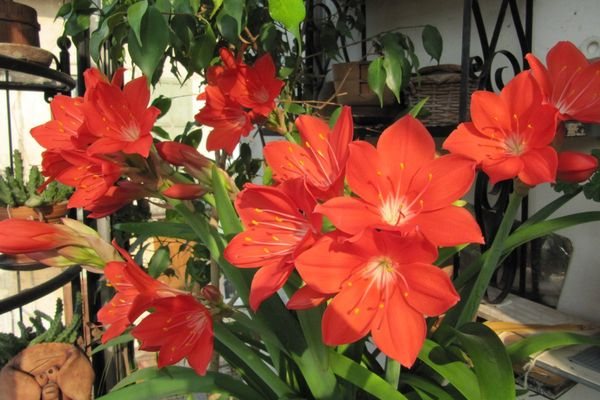

In summer, pots with zirtanthus are placed next to original stones and wooden products. The plant loves fresh air. Often, pots with bright bells are placed in flower beds and even hung in pots.
Signs and superstitions
According to popular beliefs, Vallotta brings peace and well-being to the house. According to superstition, due to the absorption of negative energy in the family, there are fewer quarrels and misunderstandings. Due to the red color, the plant creates coziness and warmth in the house. Since it does not require frequent maintenance, and it is almost impossible to ruin Vallota by missing 1-2 waterings, you will never be upset with a wilted plant, and your nerves will be in order.
Related entries:
- Beloperone with bright feather flowers seems to have come from the fictional world of Red, yellow, the iridescent flowers of Beloperone growing indoors will attract so much attention that you will start it even a little ...
- Heather - 4 ways to propagate a plant with unique medicinal properties Enjoy the purple or pink flowers of a beautiful field bush, growing it at home. Contents1 Description of the plant2 Origin of the name3 Homeland ...
Care errors
Vallota is quite hardy and patiently endures the "experiments" of a novice grower. However, its decorative effect can be significantly affected. The main problem is the lack of flowering, for which, in fact, the vallot is grown.
Table: why the plant does not bloom, turn yellow, dry or fall off the leaves
| Error | Cause | Elimination |
| Vallota does not bloom |
|
|
| The tips of the leaves turn yellow and dry. Yellow spots appear |
|
|
| The tips of the leaves turn brown, the base rots. The leaves are easily detached from the bulb. | Excessive soil moisture. | Let the potting soil dry. Then water according to the rules, focusing on the room temperature. |
| The peduncle is deformed - thick and short |
|
|
| Leaves fade, turn pale, thin | Lack of nutrients. | Do not forget that during the growth period, the vallot needs additional feeding. |
| Leaves turn yellow and gradually fall off |
|
|
Soil selection, pot, transplant
The roots are juicy, fragile, not very long, easily rotting. They don't need a lot of land. Therefore, the wallot is transplanted only when the urgent need is ripe, usually once every 3-4 years, in the spring.
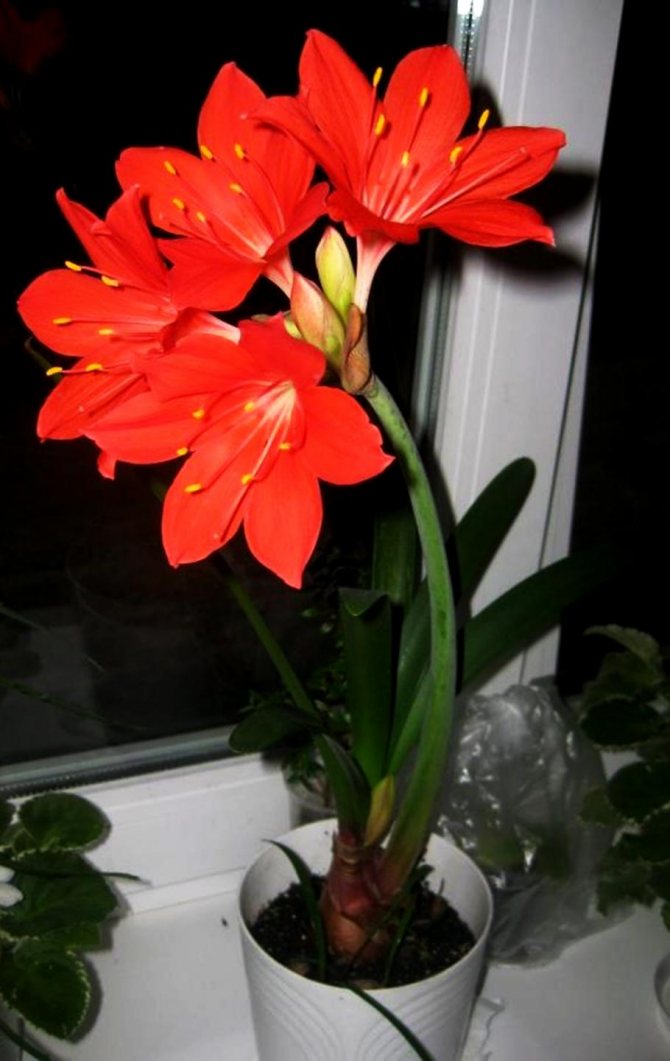

Vallota doesn't like transplants
Another reason in favor of a rare transplant is that the fire lily blooms better in a cramped pot. When choosing a container for a plant, stop at a narrow, but high one. A narrow pot will not allow the wallot to grow many children. In wide, young onions will grow in abundance. Because of this, the plant does not have enough strength to bloom. A wider capacity is needed when you plan to propagate a vallot or plant several onions at once.Take care of the drainage holes in the pot.
If you have purchased a Valotta bulb, plant it immediately. Evergreen varieties can do without leaves for some time, but this existence is difficult to endure. Therefore, help the plant gain leaves faster.
The vallot is not picky about the soil. But for healthy development and annual flowering, you need nutritious and loose soil and always high-quality drainage: broken brick, expanded clay, clay shards, gravel, vermiculite. It will protect you from putrefactive diseases. Approximate soil compositions:
- universal soil from the store with the addition of vermiculite;
- Mix 3 parts of sod land with 2 parts of leafy land and peat, add partly rotted mullein and sand;
- leaf and sod land (3: 2), peat and sand (2: 1);
- deciduous and sod land in half, 1 part of humus and sand;
- mix equally sod, leafy soil and sand, instead of which chopped sphagnum is suitable;
- peat, leaf and sod land equally and half of the sand and manure.
How to plant a wallot
- Before planting, sterilize the soil (or its components separately), drainage and pot. Place a drainage layer at least 2 cm thick on the bottom, on top of some soil.
- Take the wallot out of the old pot, carefully separate the children.
- Shake off the old earth slightly, leaving it in the roots. Remember: they are very delicate.
- Examine the roots, remove rotten ones, sprinkle with charcoal.
- Place the onion in a new container.
- Gently cover it with soil, leaving two-thirds or half of the top above the soil level. Water the plant and place it in a slightly shaded area for better adaptation.
- When growth begins, move the wallot on a sunny windowsill.
The vallotta bulbs are not deeply buried, so that later it would be easier to separate the formed babies. The growth appears in the upper part, so the young onions will be almost on the surface, all that remains is to harvest the "harvest" without disturbing the dormancy of the mother plant.
Preparation and flowering period
With proper care, the villlota bulb produces flower stalks twice a season. The life of one stem with flowers is 5 days. At the same time, 2-3 buds can bloom at once.
In April, the vallota will begin to wake up, this can be understood by the growth of new leaves. In this case, you can slightly increase the temperature of the content, but prevent the heat, which the vallotta does not tolerate. 20-24 ° C is quite enough.
The feeding is resumed, which must be done every 14 days. The easiest and most practical option is to use ready-made complex liquid fertilizers for flowering.
When the plant will release a peduncle, and this will be already at the end of spring or summer, feeding does not stop, you can replace the main drug with a phosphorus-containing one that stimulates flowering. Watering is carried out in moderation, but does not allow the top layer to dry out. The ideal condition of the soil is always slightly moistened, excess water in the sump must be drained.
Why Vallota does not bloom and what to do
A beauty may refuse to bloom for several reasons:
- The selected container for the flower (pot) is too large and the plant switches to reproduction of children.
- The plant has not been transplanted for a long time. A lot of children have accumulated, which distract and draw out all the nutrients.
- The rest period has not been sustained. The plant is not rested to accumulate strength for flowering.
Only strict adherence to all recommendations for transplanting, watering, feeding will bring results. Then the vallot is able to attract attention with its flowering more than once a year.
Beautiful Vallota Cyrtanthus elatus, Vallota speciosa
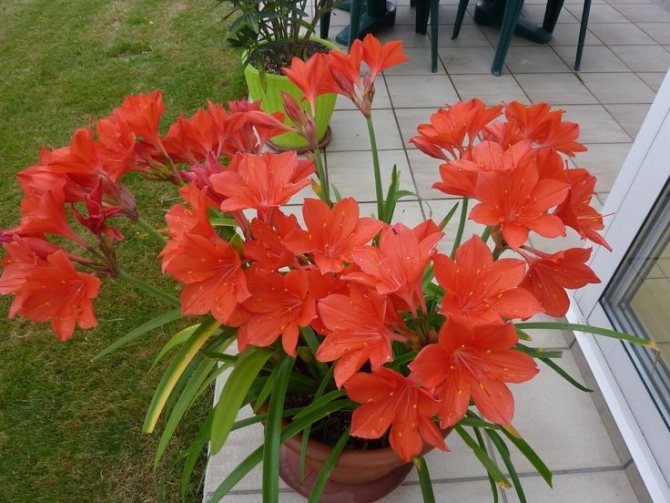

Vallota lovely indoor plants photo of flowers
A distinctive feature is the leaves with a dark olive tint, up to 45 cm long and 3 cm wide.With age, the size of the bulb increases, reaching 4 cm in diameter by the beginning of flowering. The separate petals of the inflorescence resemble an oval shape with a pointed end. Their number reaches 7 pieces. All inflorescences are directed, look like an open umbrella. The hollow stem of the inflorescence rises to a height of 0.6 m. It blooms at the end of summer (in an extreme case, the beginning of autumn), is unusually similar in flowering to a lily.


